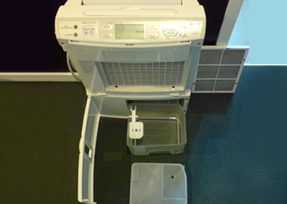What is an energy-efficient dehumidifier?
An energy-efficient dehumidifier reduces the moisture content in the air with minimum energy usage. The efficiency of any dehumidifier is measured by the quantity of water (in liter/pints) that it can remove from the air indoors per kilowatt-hour.
Where does humidity come from?
Humidity is present in most houses due to the air that circulates within from outside. Leakage of air from gaps around floors, ceilings, doors, windows easily allows humid air to enter. Basements of houses are usually cooler and can cause condensation of water from the humidity in the air. Water seepage and formation of water vapor from activities like cooking, drying clothes can also add to the humidity of an average home by around 80 liters, i.e. 20 gallons a day.
How does an energy-efficient dehumidifier work?
The moisture in the air is removed by the dehumidifier through its compressor, fan and condenser coil. In simple words, it acts as a refrigerator, except that its main function is to remove water from the humid air instead of cooling it. A dehumidifier continues to work until its tank is full or the moisture in the air reaches a preset low threshold. Automatic drainage of the water collected into a floor level drain ensures that the dehumidifier does not need constant attention. Another alternative is to have a visual indicator that switches on when the water tank is full.
How does one select the right energy-efficient dehumidifier?
The right way to select an ideal energy-efficient dehumidifier is by checking its extraction capacity and tank capacity.
Extraction Capacity: This reflects the amount of water it can extract from the air within 24 hours.
Tank Capacity: This reflects the amount of water the tank is capable of holding
The more water the dehumidifier can extract per kWh the better. This energy factor ranges from 3.56 which is the best to 1.2 which is pretty low.
Portable dehumidifiers are ideal for small spaces that tend to be humid in hot weather or well sealed rooms where condensation on windows and walls is a problem in winter.
What can be done to make the dehumidifier more energy-efficient?
- Closing the doors of the basement helps in keeping moist air out. This will reduce the load on the dehumidifier and help it to function better.
- The coil and fan of the dehumidifier should be cleaned regularly. Washable dust filters are an option to keep the dust from settling on the coils. Run a vacuum cleaner over the coils to clear the dust.
- During woodworking or sanding it is best to cover up the dehumidifier to keep the dust out.
- Setting a timer on the dehumidifier helps in saving energy and reduces energy bills.
...Read more
Close










